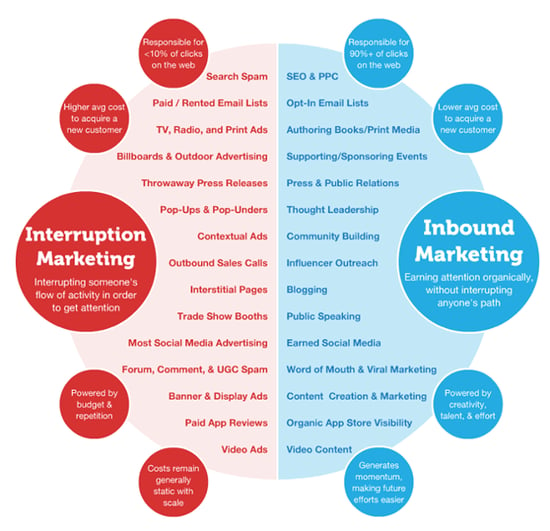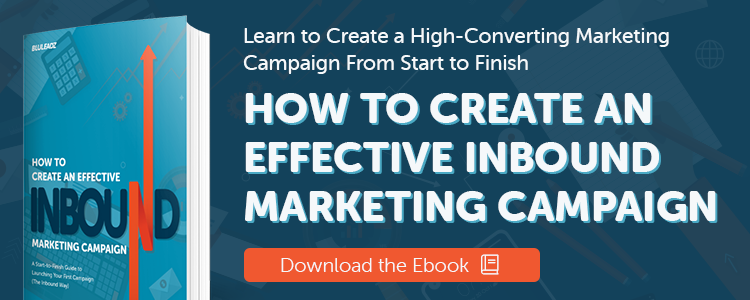By now, most professionals have at least heard the term “inbound.” If not in the context of HubSpot’s massive annual business event, then they’ve heard it in the context of marketing.
It’s easy to shrug it off as just another buzzword. But the concept of inbound marketing is a lot more involved and valuable than a BS industry term.
What Is Inbound Marketing?
Inbound marketing is the most successful long-term digital marketing strategy out there today.
Today’s world is consumer-driven, no matter whether that consumer is a stressed out homemaker or a high-powered B2B decision maker. Not everyone influenced by inbound marketing knows it by that name, but all have come to expect it as the main way any brand should relate to them.
Why is that?
Simply put, inbound marketing focuses on the needs of your would-be buyer in a way that old-fashioned, high-pressure outbound marketing can’t. In a world with hundreds or thousands of potential vendors, nobody has time for pushy tactics from a random stranger.
Inbound marketing is the process of attracting, engaging, and delighting people to grow a business that is trustworthy, credible, and consistently providing value for their audience.
How Inbound Differs From Outbound Marketing
The inbound framework is all about delivering valuable content to attract the right audience to your site. It’s focused on educating potential buyers about their best options, not on pushing messaging or being disruptive.
Outbound, on the other hand, is very disruptive. In fact, outbound marketing is often referred to as interruption marketing or push marketing.
As you can imagine, these two approaches differ in many ways, which is evident when you look at the strategies associated with them.

Source: WordStream
As you can imagine, there are plenty of advantages to using inbound marketing.
The Benefits of Inbound Marketing
The way you approach marketing greatly impacts your business and the entire customer experience.
And when it comes time to make a change to inbound from outbound, many marketers are left wondering how to make the jump and what it takes to measure its ROI.
It’s not difficult, but it does call for a change in mindset.
There are three major noteworthy benefits of adopting an inbound marketing strategy to keep in mind as you adopt this new approach.
It Helps You Increase Traffic.
No matter what you have to offer, everything starts with traffic. But it has to be the right traffic.
Inbound marketing addresses this in two important ways:
- It raises visibility by generating great content that gets shared and raises search ranking.
- It allows you to help, inform, and connect with your ideal buyers in the prospect stage.
As long as your inbound marketing campaigns are speaking to the right audience, you’ll start to attract quality traffic sooner rather than later. This is essential: Traffic that uses up your bandwidth and other technical resources but doesn’t convert is pure overhead.
Although inbound marketing takes some time to gain traction, it is more cost-effective than paid traffic in the long run. It also accumulates momentum over time – unlike pay per click (PPC) traffic, which has a tendency toward flat or even diminishing returns.
Once established, virtually free traffic from inbound marketing can fuel an entire enterprise.
It Gets You More Qualified Leads.
Web traffic, though vital, is only the first step in the value chain.
It’s raw material that has to be directed and fashioned into bottom line results. Where inbound marketing really excels is in the ability to find and cultivate relationships with truly qualified leads.
Thanks to the way it incorporates your knowledge of your customers – through buyer journeys, personas, and more – inbound marketing is laser-focused on leads who are ready to do more than just think about the problem at hand.
A segmented inbound marketing strategy lets you meet people wherever they are and give them the resources and motivation to take the next step. As they utilize your web content, they:
- Learn facts and terminology they’ll need to tackle their problem or question.
- Establish buying criteria to help them understand what a solution looks like.
- Compare and ultimately select a solution that will deliver their requirements.
Whereas outbound marketing is a dragnet that tries to capture everyone who might even possibly be interested in a solution, inbound is a guided journey from a defined pain to an ideal solution.
Every piece of content fosters trust and shows the value your future customers can expect.
It Provides a Higher Lead-to-Customer Conversion Percentage.
The more time you can spend on high-value leads who are ready to convert, the better.
Inbound marketing can’t do everything, but it automates away a lot of time-consuming work. Virtually every time you create a new piece of web content, for example, that content can continue building search visibility and attracting leads forever.
Since your campaigns naturally do lots of the heavy lifting in nurturing and maintaining the lead relationship, your sales team will have more time for one-to-one interaction with best-qualified leads. Ultimately, that means more conversions at every step, including the big sale.
Because more customers will reach the end of their journey, your marketing team will have more fresh insights on what your different buyer personas are thinking right now. That, in turn, means you can refine your marketing campaigns to zoom in on emerging needs and do even better next time.
Those insights come in the form of your analytics.
What Metrics You Need to Measure to Understand Inbound Marketing Results
To prove the true ROI of your inbound marketing efforts, you first need to understand the results you're generating.
Start by looking at KPIs of your marketing, which can include:
- Leads being generated – how many leads are you earning each month?
- Marketing qualified leads (MQLs) – how many leads are qualified as high, medium, and low?
- Sales qualified leads (SQLs) – how many leads raised their hands and contacted sales directly?
- Opportunities – how many SQLs have advanced through the sales funnel toward becoming a new customer?
- New customers – how many new closed deals did you get?
- Customer acquisition cost (CAC) – how much does it cost for you to acquire a new customer?
- Customer lifetime value (CLV) to CAC ratio – what is the ratio of how much a customer is worth over their lifetime to the cost of acquiring them?
How to Calculate the ROI of Inbound Marketing
When you’re reporting on the aforementioned KPIs, you need to weigh the data against the costs of operating your marketing department.
Look at your internal team’s compensation costs or the amount you’re spending if you’re outsourcing to an agency. Other considerations include:
- How much you’re spending on marketing technology
- How much time and how many people are involved in your content creation process
- How many resources are used in your content promotions (e.g., email marketing, social media marketing, public relations, etc.)
When you're looking at the right metrics and measuring the cost of your inbound marketing, you have all the numbers you need to get to the bottom of your ROI.
Start Inbound Today and Keep Measuring Performance
Putting the right analytics solutions in place to clarify your data is step one to lasting success of your inbound marketing efforts.
When you have your reports ready, you can evolve your strategy as you gather more insights. This, in turn, maximizing your ROI over time.
Bottom line: inbound marketing is data driven, meaning it's inherently designed to drive better results over time.
Your decision to invest in inbound is not a question of if you can get started. It's a question of if you can actually afford to continue neglecting your marketing.
The longer you delay, the more leads and sales you're leaving for your competitors.


Jeff Previte
I am a Content Manager at Bluleadz. I enjoy spending time outdoors -- camping, hiking, hammocking, and everything in between. I also love reading, writing, and learning how to play guitar.